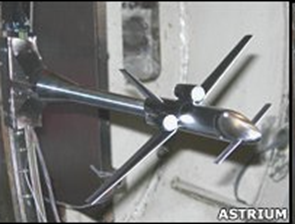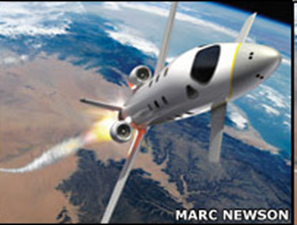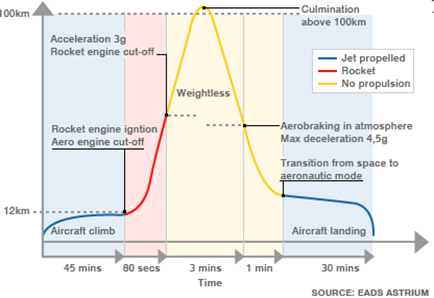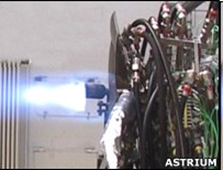Space planes 'to meet big demand'

Aerospace giant EADS says it will need a production line of rocket planes to satisfy the space tourism market.
The European company's Astrium division, makers of the Ariane rocket, has plans for a commercial vehicle to take ticketed passengers above 100km.
Its market assessment suggests there could be 15,000 people a year prepared to part with substantial sums of money for the ride of a lifetime.
Astrium anticipates it be will be producing about 10 planes a year.
"To satisfy the market you will need more planes than you think, because once there is regular operation, the price will decrease which means there will be more customers," Robert Laine, chief technical officer (CTO) of the pan-European company, told BBC News.

"It will develop towards a classical aeronautical business model. Someone will build the planes; somebody will operate them; somebody will sell the tickets; somebody will provide the accommodation - like any tourism."
The first tickets will retail in the region of 150,000-200,000 euros (£115,000-160,000).
Mr Laine was speaking in London at the Institution of Engineering and Technology, where he was delivering the 99th Kelvin Lecture.
Astrium does not intend to run a space tourism marketing operation itself. Rather, it intends simply to supply vehicles to those who will.
And although production numbers will not be in the same league as, say, Airbus or Boeing, they will be significant nonetheless.
Mr Laine said development of Astrium's rocket plane was proceeding apace.
Wind tunnel testing has proven the aerodynamic shape; and the vehicle's Romeo rocket engine which will take the plane above 100km has been ignited for burns that have run up to 31 seconds.
The engine will be using the combustion of a liquid oxygen-methane propellant to provide the more than 1km/s punch needed to break through the top of the Earth's atmosphere.
About 50% of the mass of the plane at take-off would be fuel.
The intention is to produce a vehicle that seats five individuals - one pilot and four passengers.
The production model will use normal jet engines to take off and climb to 12km.
From there, the rocket engine will kick the vehicle straight up, taking it beyond 60km in just 80 seconds. By the time the rocket shuts down, the craft should have sufficient velocity to carry it above 100km - into space.

As the plane then begins to fall back to Earth, the pilot will use small thrusters to control its attitude, keeping the plane's belly flat to the Earth.
"If you enter with the belly flat down then you expose a very large radius to the aerodynamic flux and that contains the temperature to an acceptable limit," explained Mr Laine.
"We calculate the temperature will be less than 100C on the surface of the wings."
When the plane slows to subsonic speed in the atmosphere, it will use its jet engines again to return to the airport.

The total journey time will be about one-and-a-half hours.
Mr Laine said the planes would have about a 10-year lifetime. They would be designed for ease of maintenance, with an operational schedule of one flight per week.
Although the rocket planes could take off and land from any airport, Astrium believes it is likely that special spaceports - possibly 10 worldwide - will operate in a few, restricted locations.
Northern Europe probably would not host one of these, Mr Laine speculated, because of the high density of other air traffic and because cloud would too frequently obscure the view of Earth.
"In Europe, I'd say the most likely location is around the Mediterranean. Why? Because there are blue skies most of the time, and because from 100km you can see mountains, the sea and the coast."
Cheaper space
The Astrium CTO acknowledged that Virgin Group boss Sir Richard Branson would be first into the market with rocket planes based on the award-winning and record-breaking SpaceShipOne concept.
But Mr Laine was confident an Astrium-fed business would be second, with a commercial service that began exactly five years after the agreement of a one-billion-euro financing deal.
He even hoped Sir Richard would be an Astrium customer - just as his airline business is a customer of the EADS Airbus division.
The CTO would not say how soon the initial financing would be in place, or reveal details about the identities of parties that were in discussion.
Long-term, Mr Laine said, space tourism had a major role to play in reducing the overall cost of space access.
He sees rocket planes being used for homeland security purposes as "quick satellites"; and as forerunners of superfast intercontinental passenger transporters.
"Today we don't know how to go to space cheaply. Being able to climb on a regular basis to 100km will give us the motivation to develop the plane that goes, not just up and down to the same place, but from here to the other side of the Earth.
"When the Ariane 5 takes off, 15 minutes later it is over Europe; and 45 minutes later it is over the Pacific. The fastest way is to go outside the atmosphere and that will be the future."
